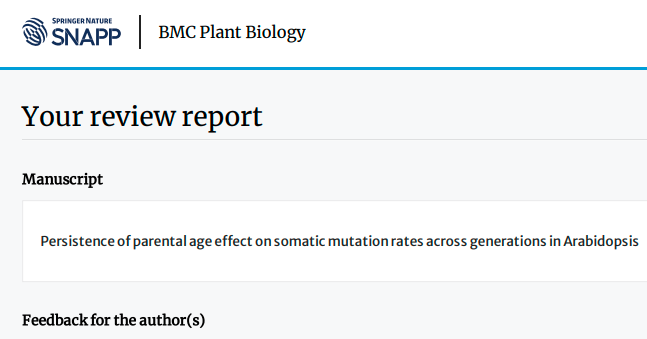刘冬博士受邀担任BMC Plant Biology杂志审稿人
我院刘冬博士受邀担任BMC Plant Biology杂志的审稿人,并审阅稿件稿件Persistence of parental age effect on somatic mutation rates across generations in Arabidopsis; 审稿工作(Comments to the author(s):)获得杂志社和主编肯定(Dear Dr Liu,Thank you for your help with the manuscript, "Persistence of
parental age effect on somatic mutation rates across generations in Arabidopsis", which you recently reviewed for BMC Plant Biology.We greatly appreciate your assistance and participation in the review process for BMC Plant Biology and hope that we can continue to benefit from your expertise on future submissions.Kind regards,Peer Review Advisors
BMC Plant Biology)。

该杂志为SCI源杂志(一类期刊),英国BMC出版社出版,所刊文章被科学索引Web of Science收录,被美国科学索引划分为植物学领域1区杂志,该杂志被高度关注为该领域TOP期刊(46/482,排名前9.54%),其影响因子为5.26。BMC Plant Biology杂志考虑发表植物生物学的所有方面的文章,包括分子、细胞、组织、器官和整个生物体的研究。
文/王伟,图刘冬
Comments to the author(s):
The manuscript describes a clever combination of tracking plant age at seed production across generations and the use of mutation reporter lines to estimate the effects of plant age and temporal changes in seed age. They investigate several types of mutation, as well as examining gene expression in several loci associated with DNA repair and epigenetic regulation.
There is much to like in this paper, especially the careful tracking of floral age across generations. However, there are a number of critical details that need to be explained that make interpretation of the results difficult in its current stage.
First, the study design and seed propagation needs to be described much more clearly. For a given reporter line, were all seed in F1 collected from the same plant (at different ages)? Then were the plants representing different DAS kept as separate lineages (which Figure 1 seems to imply)? How many plants represented each lineage at each generation? In part, it is important to evaluate whether any of the screened mutations was being passed between generations. The authors need to provide an extremely explicit and detailed description of how the plant material was generated, as this is critical to evaluating the differences in mutation.
Second, it is not at all clear how the “generation” effect can be disentangled from an environmental effect. Were plants of each generation all raised at the same time? It would be difficult in this case to remove an effect on the global growth environment (gradual changes in light intensity, soil quality at the time of sowing, etc.) that changed that affected all of the plants of that generation. Such an effect could explain some of the similar patterns observed—why generation 4 plants had similar effects, and then generation 5 plants had similar effects—if all the generation 4 plants experience an environment that influences the measured characters, and then all the generation 5 plants experienced a different shared environment—then this could be misattributed as a generational effect on mutation characters.
Third, the authors need to be more careful not to overstate their findings. Although the mutation reporter lines are an intriguing and important way of measuring mutation events under different circumstances, they do not necessarily represent the entire genome. There is considerable evidence that there is substantial variation in mutation rates across the Arabidopsis genome, depending on chromatin availability, CG content, epigenetic marks, proximity to transposable elements, etc. The authors need to be very clear about the limitations of their results—they can only be stated with certainty to apply to the reporter locus. Expansions beyond that conclusion are inferential, and probably become less accurate with sequence types that have fundamentally different mutation properties.
Fourth, the manuscript would be stronger if there was some sequence verification of the mutations. Some of the estimates of mutation rates seem high (and there is little effort to scale them to other published studies). Some verifications by sequencing could also illuminate whether the types of mutation patterns are consistent with higher mutations of methylated cytosines, or what was driving the patterns of genomic instability, etc.
There are a few areas where the paper needs to be built up. There are very few suggested mechanisms for the patterns that are observed—the discussion should be focused more on possible biological origins of the described patterns, and less on long descriptions of differences between this study and other studies. In general, the role of epigenetic factors and other factors known to associate with mutation parameters in Arabidopsis need to be discussed much more thoroughly. Overall, the language is often overly vague (instead of specifically describing patterns) and there are a number of typos, so if the authors address the broader issues they will also need to complete a careful edit to correct these more minor issues.
Fifth,At ABSTRACT, they could better clarify the objectives of this work (for example, specific values of somatic mutation rates across generations).
Sixth,Are there any phenotypic differences between somatic mutation Arabidopsis and its parents?
Seventh,Figure 14 is hardly visible, and they should be larger (data and labels are too small)
Eighth, Line 547: 3905- >3,905; 3336- >3,336; 4027- >4,027; 4415- > 4,415.
Ninth, Line 628: The version of the software prism should be given.The font format of reference 4 is not consistent with other references.
